NCERT Solutions Class 10 Maths Chapter 3: Pair of Linear Equations in Two VariablesExercise 3.11. Aftab tells his daughter, "Seven years ago, I was seven times as old as you were then. Also, three years from now, I shall be three times as old as you will be." (Isn't this interesting?) Represent this situation algebraically and graphically. Solution Let the present age of Aftab (in years) = x, and let the present age of his daughter (in years) = y. Aftab's age seven years ago = x - 7 and his daughter's age seven years ago = y- 7 It is given that 7 years ago, Aftab was 7 times as old as his daughter. Therefore, x - 7 = 7(y - 7) x - 7 = 7y - 49 x - 7y = 7 - 49 x - 7y = -42 ...Equation (I) Aftab's age three years later = x + 3 and his daughter's age three years later = y + 3 It is given that 3 years later, Aftab will be 3 times as old as his daughter. Therefore, x + 3 = 3(y + 3) x + 3 = 3y + 9 x - 3y = 9 - 3 x - 3y = 6 ...Equation (II) We now have the two required equations. Next we need to put in some values for any one variable and find the other in order to find the required coordinates to mark the graph. We will be putting values in x and calculating y from the equation. NOTE : Since students have the freedom to assume any values they desire, it is recommended to pick the ones that make calculations easierFor Equation (I):
For Equation (II):
The following graph will be obtained upon plotting the equations: 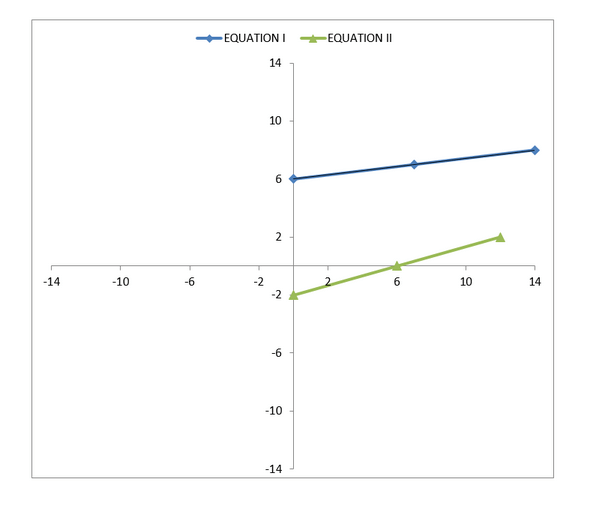
2. The coach of a cricket team buys 3 bats and 6 balls for Rs 3900. Later, she buys another bat and 3 more balls of the same kind for Rs 1300. Represent this situation algebraically and geometrically. Solution Let the cost of 1 bat (in rupees) = x, and let the cost of 1 ball (in rupees) = y. It is given that the cost of 3 bats and 6 balls (in rupees) is 3900. Therefore 3x + 6y = 3900 ... Equation (I) It is given that the cost of 1 bat and 3 balls (in rupees) is 1300. Therefore x + 3y = 1300 ... Equation (II) Next we need to put in some values for any one variable and find the other in order to find the required coordinates to mark the graph. We will be putting values in x and calculating y from the equation. NOTE : Since students have the freedom to assume any values they desire, it is recommended to pick the ones that make calculations easierFor Equation (I):
For Equation (II):
The following graph will be obtained upon plotting the equations: 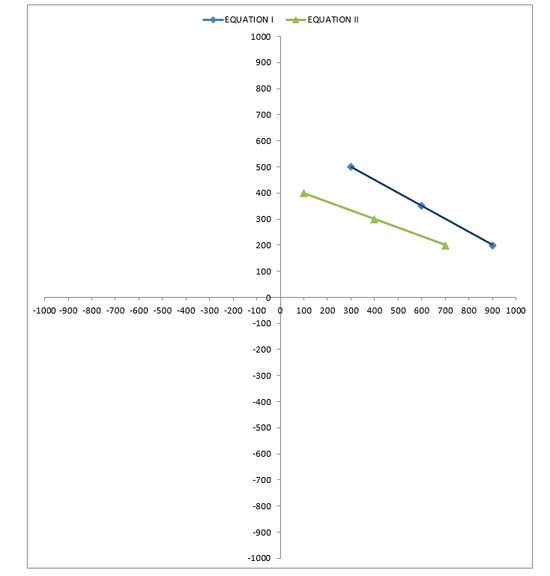
3. The cost of 2 kg of apples and 1kg of grapes on a day was found to be Rs 160. After a month, the cost of 4 kg of apples and 2 kg of grapes is Rs 300. Represent the situation algebraically and geometrically. Solution Let the price of 1kg of apples (in rupees) = x, and let the price of 1kg of grapes (in rupees) = y. It is given that price of 2kg apples and 1kg grapes was 160 rupees. Therefore 2x + y = 160 ... Equation (I) It is given that later price of 4kg apples and 2kg grapes was 300 rupees. Therefore 4x + 2y = 300 ... Equation (II) Next we need to put in some values for any one variable and find the other in order to find the required coordinates to mark the graph. We will be putting values in x and calculating y from the equation. NOTE : Since students have the freedom to assume any values they desire, it is recommended to pick the ones that make calculations easierFor Equation (I):
For Equation (II):
The following graph will be obtained upon plotting the equations: 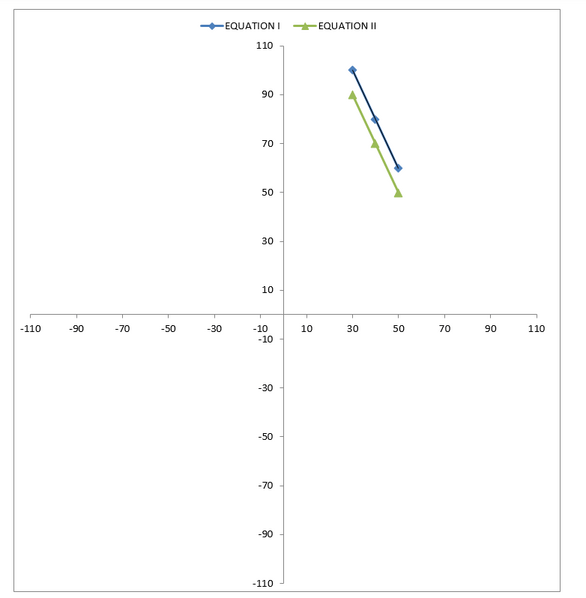
Exercise 3.21. Form the pair of linear equations in the following problems, and find their solutions graphically.
Solution I. Let the number of girls = x and let the number of boys = y. Only 10 students participated in the quiz. Therefore, x + y =10 ... Equation (I) Since, the number of girls is 4 more than the number of boys. Therefore, x = y + 4 ... Equation (II) Next we need to put in some values for any one variable and find the other in order to find the required coordinates to mark the graph. We will be putting values in x and calculating y from the equation. NOTE : Since students have the freedom to assume any values they desire, it is recommended to pick the ones that make calculations easierFor Equation (I):
For Equation (II):
The following graph will be obtained upon plotting the equations: 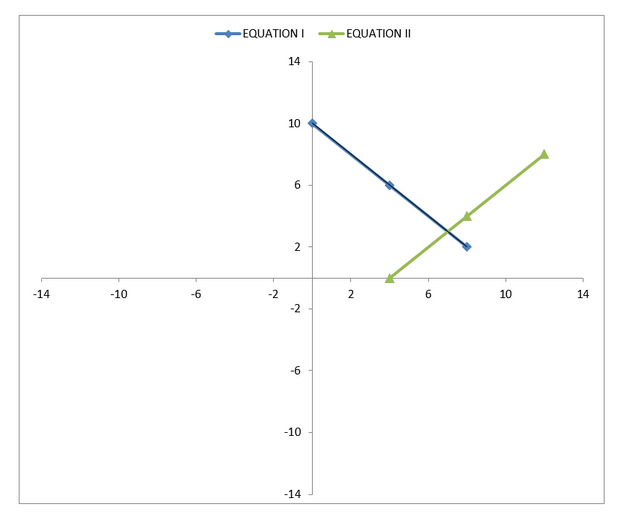
The graph will intersect at (7, 3). Therefore, x = 7 and y = 3. Hence, the number of girls that participated in the quiz = 7 and the number of boys that participated in the quiz = 3. II. Let the cost of 1 pencil = x (in rupees) and let the cost of 1 pen = y (in rupees). It is given that the cost of 5 pencils and 7 pens is Rs 50. Therefore, 5x + 7y = 50 ... Equation (I) It is also given that the cost of 7 pencils and 5 pens is Rs 46. Therefore, 7x + 5y = 46 ... Equation (II) Next we need to put in some values for any one variable and find the other in order to find the required coordinates to mark the graph. We will be putting values in x and calculating y from the equation. NOTE : Since students have the freedom to assume any values they desire, it is recommended to pick the ones that make calculations easierFor Equation (I):
For Equation (II):
The following graph will be obtained upon plotting the equations: 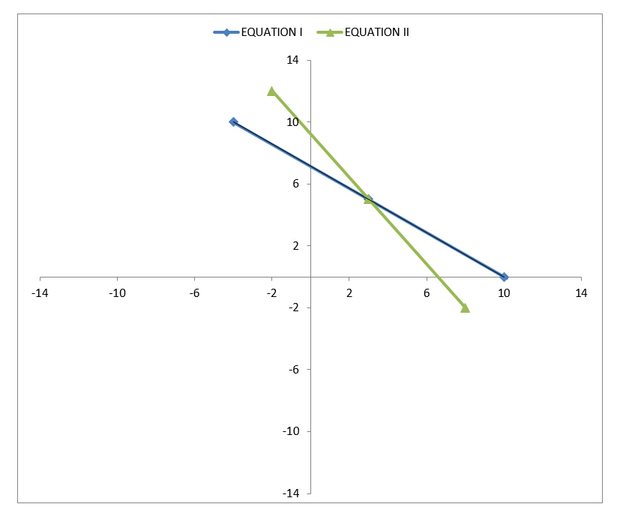
The graph will intersect at (3, 5). Therefore, x = 3 and y = 5. Hence, the price of one pencil (in Rupees) = 3 and the price of one pen (in Rupees) = 5. 2. On comparing the ratios a1/a2 , b1/b2 ,c1/c2 , find out whether the lines representing the following pairs of linear equations intersect at a point, are parallel or coincident:
Solution I. On comparing the given equations with a1x + b1y + c1 = 0 and a2x + b2y + c2 = 0 respectively, we get a1 = 5, b1 = -4, c1 = 8 and a2 = 7, b2 = 6, c2 = -9 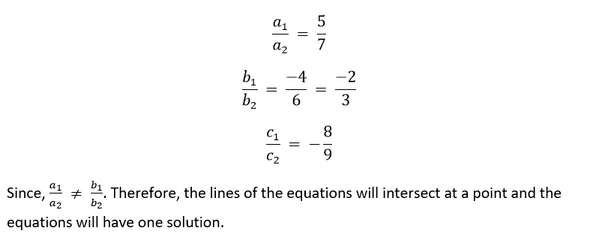
II. On comparing the given equations with a1x + b1y + c1 = 0 and a2x + b2y + c2 = 0 respectively, we get a1 = 9, b1 = 3, c1 = 12and a2 = 18, b2 = 6, c2 = 24 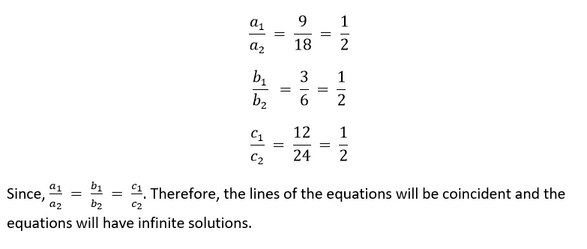
III. On comparing the given equations with a1x + b1y + c1 = 0 and a2x + b2y + c2 = 0 respectively, we get a1 = 6, b1 = -3, c1 = 10and a2 = 2, b2 = -1, c2 = 9 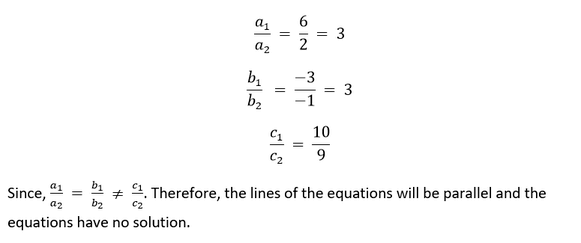
3. On comparing the ratios a1/a2 , b1/b2 ,c1/c2 , find out whether the lines representing the following pairs of linear equations are consistent or inconsistent:
Solution 1. On comparing the given equations with a1x + b1y + c1 = 0 and a2x + b2y + c2 = 0 respectively, we get a1 = 3, b1 = 2, c1 = -5and a2 = 2, b2 = -3, c2 = -7 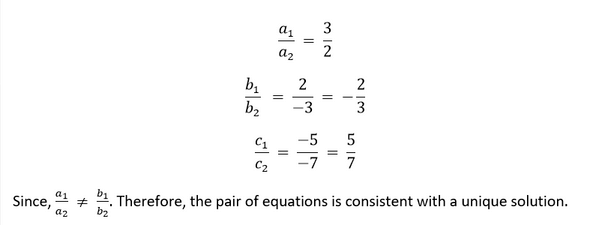
2. On comparing the given equations with a1x + b1y + c1 = 0 and a2x + b2y + c2 = 0 respectively, we get a1 = 2, b1 = -3, c1 = -8and a2 = 4, b2 = -6, c2 = -9 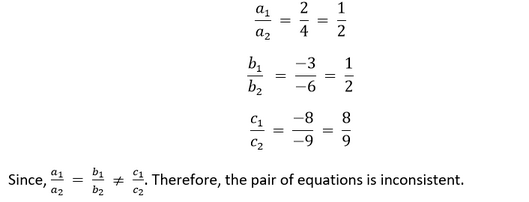
3. On comparing the given equations with a1x + b1y + c1 = 0 and a2x + b2y + c2 = 0 respectively, we get a1 = 3/2, b1 = 5/3, c1 = -7and a2 = 9, b2 = -10, c2 = 14 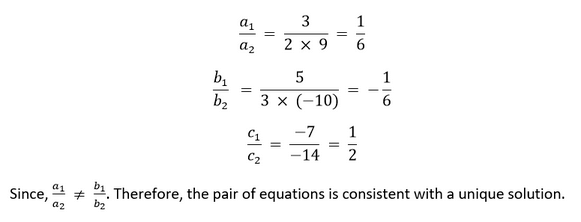
4. On comparing the given equations with a1x + b1y + c1 = 0 and a2x + b2y + c2 = 0 respectively, we get a1 = 5, b1 = -3, c1 = -11and a2 = -10, b2 =6, c2 = 22 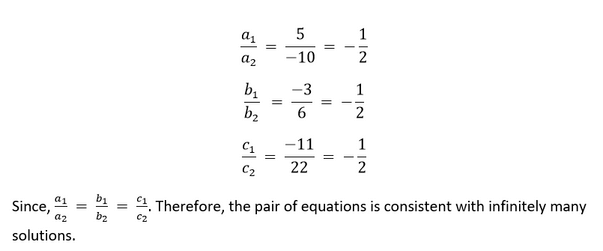
5. On comparing the given equations with a1x + b1y + c1 = 0 and a2x + b2y + c2 = 0 respectively, we get a1 = 4/3, b1 =2, c1 = -8and a2 = 2, b2 = 3, c2 = 12 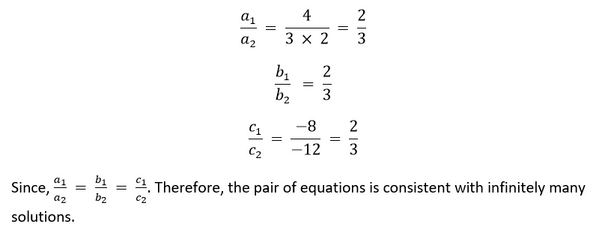
4. Which of the following pairs of linear equations are consistent/inconsistent? If consistent, obtain the solution graphically:
Solution 1.On comparing the given equations with a1x + b1y + c1 = 0 and a2x + b2y + c2 = 0 respectively, we get a1 = 1, b1 = 1, c1 = -5and a2 = 2, b2 = 2, c2 = -10 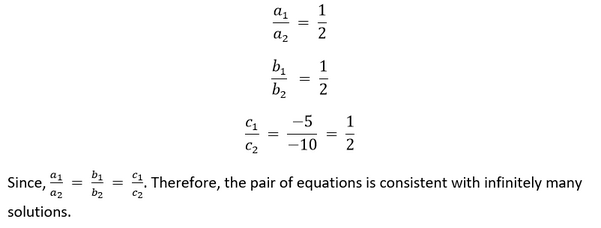
x + y = 5 ... Equation (I)
2x + 2y = 10 ... Equation (II)
The graph obtained is coincident. 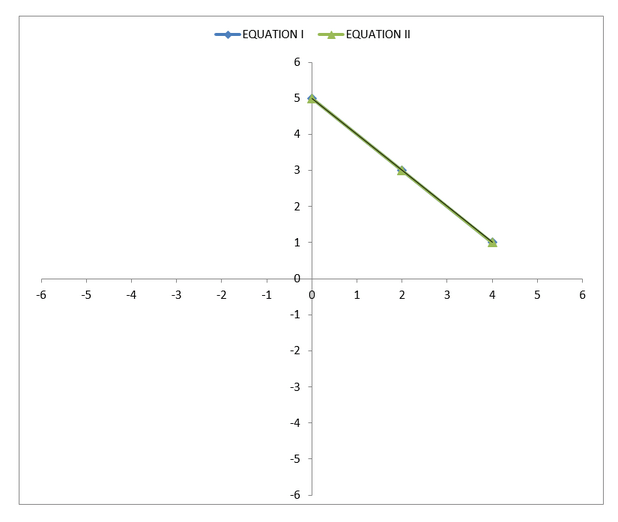
2. On comparing the given equations with a1x + b1y + c1 = 0 and a2x + b2y + c2 = 0 respectively, we get a1 = 1, b1 = -1, c1 = -8and a2 = 3, b2 = -3, c2 = -16 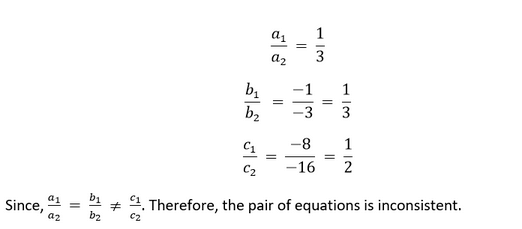
x - y = 8 ... Equation (I)
3x - 3y = 16 ... Equation (II)
The graph obtained is parallel. 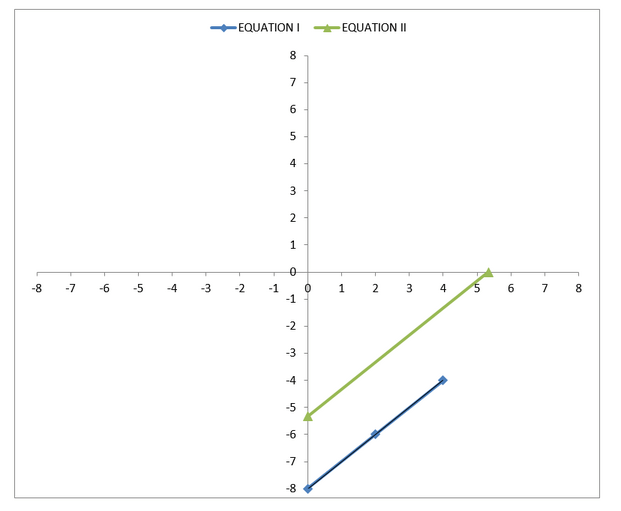
3. On comparing the given equations with a1x + b1y + c1 = 0 and a2x + b2y + c2 = 0 respectively, we get a1 = 2, b1 = 1, c1 = -6and a2 = 4, b2 = -2, c2 = -4 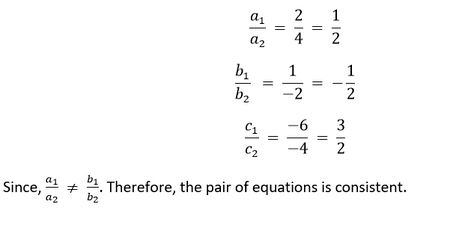
2x + y - 6 = 0 ... Equation (I)
4x - 2y - 4 = 0 ... Equation (II)
The graph obtained is coincident. The solution will be (2, 2) as obtained from graph. 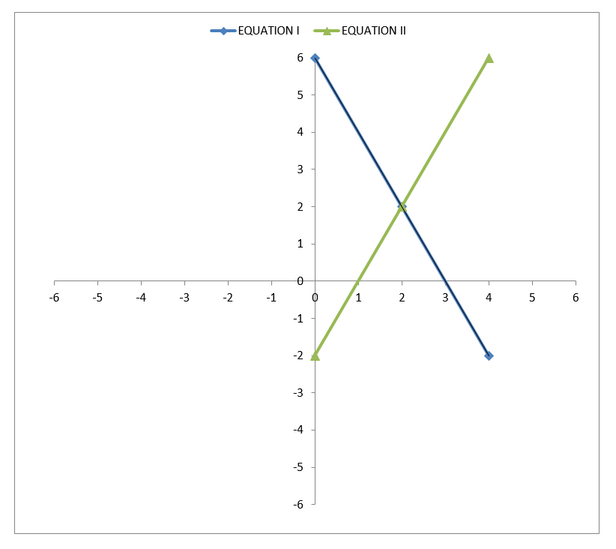
4. On comparing the given equations with a1x + b1y + c1 = 0 and a2x + b2y + c2 = 0 respectively, we get a1 = 2, b1 = -2, c1 = -2and a2 = 4, b2 = -4, c2 = -5 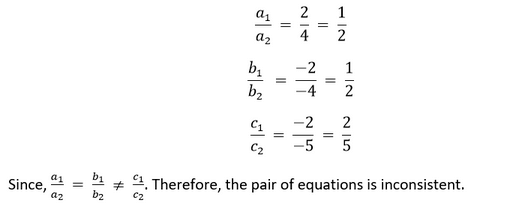
2x - 2y - 2 = 0 ... Equation (I)
4x - 4y - 5 = 0 ... Equation (II)
The graph obtained is parallel. 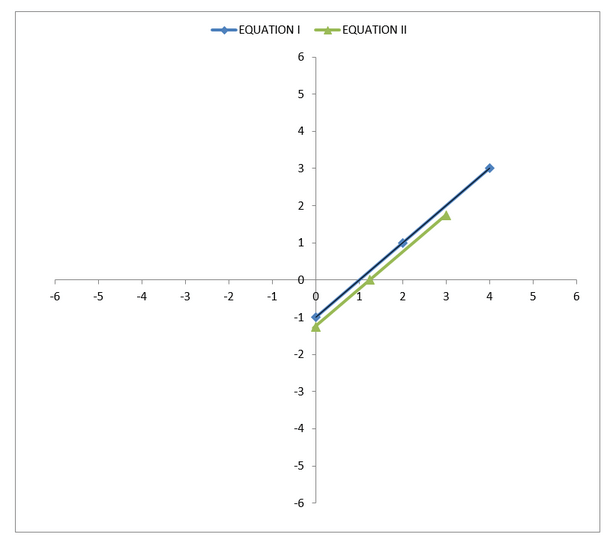
5. Half the perimeter of a rectangular garden, whose length is 4 m more than its width, is 36 m. Find the dimensions of the garden. Solution Let the length of the garden (in m) = x and Let the width of the garden (in m) = y Since, the length of the garden is 4 m more than the width of the garden, therefore x = y + 4 x - y = 4 ... Equation (I) It is also given in the problem that half of the perimeter of the rectangular garden is 36m, which implies that the perimeter is double of 36 m. We know that the perimeter will be equal to 2(l + b). Hence, 2 × (x + y) = 2 × 36 x + y = 36 ... Equation (II) Next we need to put in some values for any one variable and find the other in order to find the required coordinates to mark the graph. We will be putting values in x and calculating y from the equation. NOTE : Since students have the freedom to assume any values they desire, it is recommended to pick the ones that make calculations easierFor Equation (I):
For Equation (II):
The graph coincides at (20, 16). Therefore, x = 20 and y = 16 is the solution for the given pair of linear equations. Hence, the length of the rectangular garden = 20 m AND the width of the rectangular garden = 16 m. 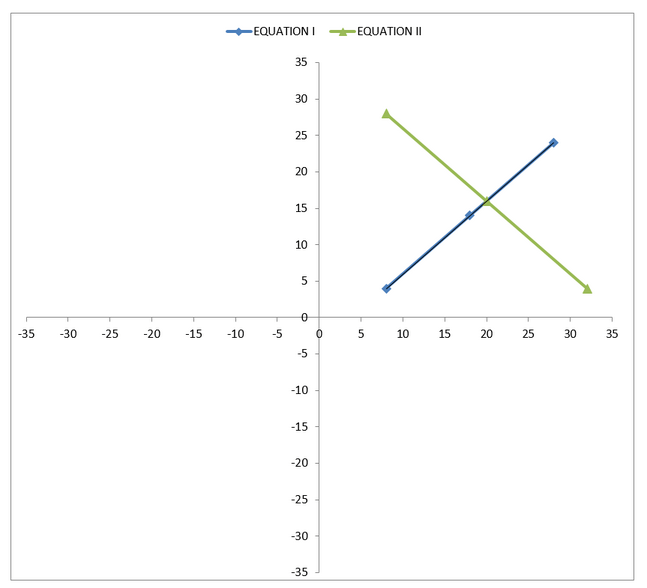
6. Given the linear equation 2x + 3y - 8 = 0, write another linear equation in two variables such that the geometrical representation of the pair so formed is:
Solution 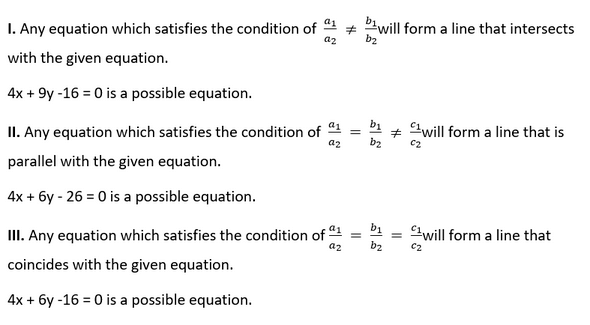
7. Draw the graphs of the equations x - y + 1 = 0 and 3x + 2y - 12 = 0. Determine the coordinates of the vertices of the triangle formed by these lines and the x-axis, and shade the triangular region. Solution x - y + 1 = 0 ... Equation (I) 3x + 2y - 12 = 0 ... Equation (II) Next we need to put in some values for any one variable and find the other in order to find the required coordinates to mark the graph. We will be putting values in x and calculating y from the equation. (NOTE : Since students have the freedom to assume any values they desire, it is recommended to pick the ones that make calculations easier)For Equation (I):
For Equation (II):
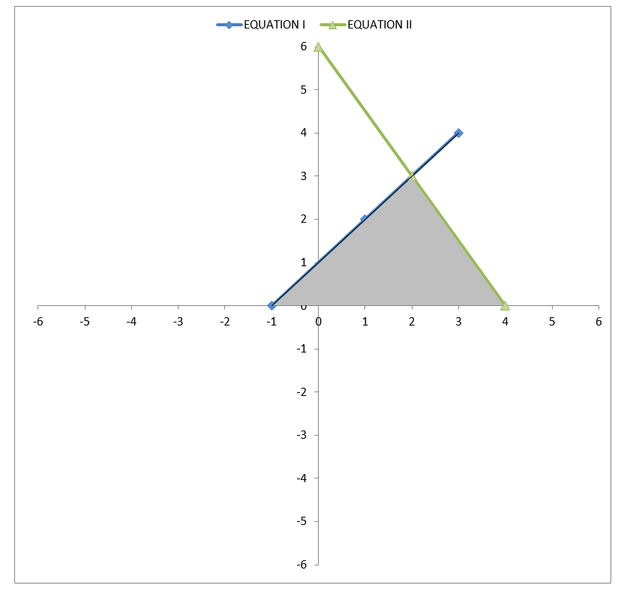
It can be seen from the graph that the vertices of the triangle formed are (-1, 0), (2, 3), and (4, 0). Exercise 3.31. Solve the following pair of linear equations by the substitution method.
Solution I. x + y = 14 x = 14 - y Substitute x = 14 - y in x - y = 4 (14 - y) - y = 4 (14 - y) - y = 4 14 - 4 = 2y 10 = 2y ⇒ y = 5 Using y = 5 in x - y = 4 x - 5 = 4 ⇒ x = 9 Hence, x = 9 and y = 5. II. s - t = 3 s - t = 3 Substitute t = s - 3 in s/3+t/2 = 6 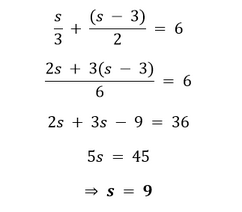
Using s = 9 in s - t = 3 9 - t = 3 ⇒ t = 6 Hence, s = 9 and t = 5. III. 3x - y = 3 3x - y = 3 Substitute y = 3x - 3 in 9x - 3y = 9 9x - 3(3x - 3) = 9 9x - 9x + 9 = 9 9 = 9 For this given pair of linear equations, there is no unique solution. Both x and y will have an infinite number of values. IV. 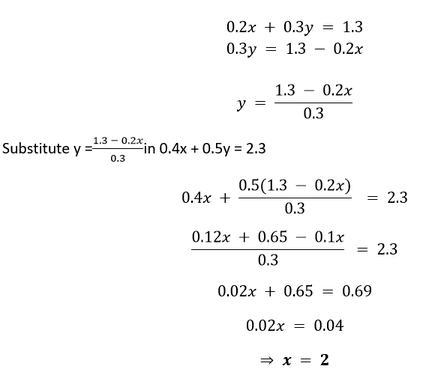
Using x = 2 in 0.2x + 0.3y = 1.3 0.4 + 0.3y = 1.3 0.3y = 0.9 ⇒ y = 3 Hence, x = 2 and y = 3. V. 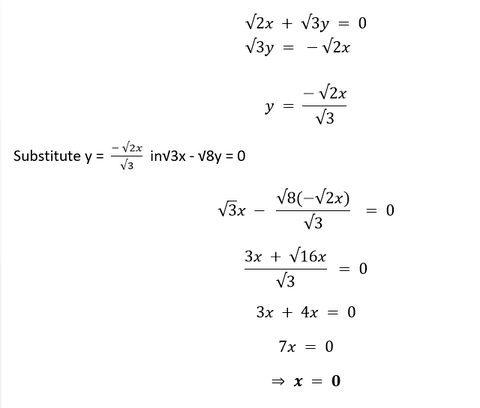
Using x = 0 in √3x - √8y = 0 0 - √8y = 0 √8y= 0 ⇒ y = 0 Hence, x = 0 and y = 0. VI. 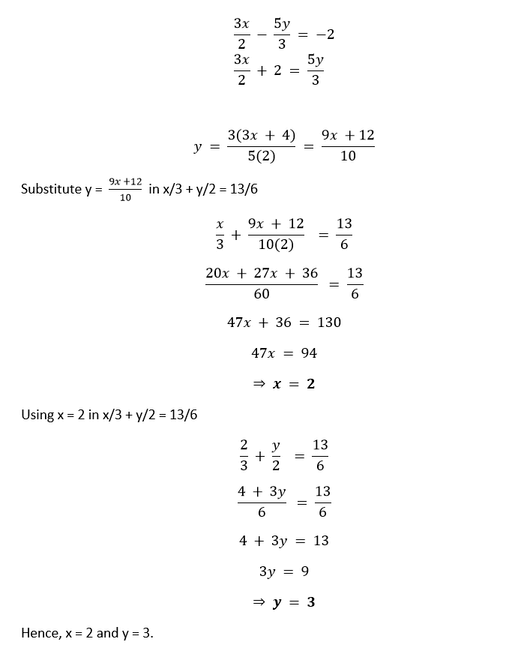
2. Solve 2x + 3y = 11 and 2x - 4y = - 24 and hence find the value of 'm' for which y = mx + 3. Solution 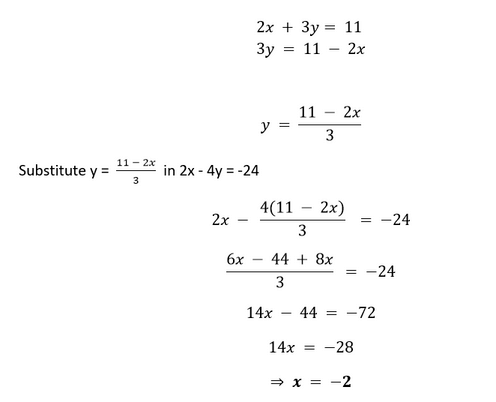
Using x = -2 in 2x - 4y = -24 2(-2) - 4y = -24 -4 - 4y = -24 4y = 20 ⇒ y = 5 Hence, x = -2 and y = 5 is the solution of the given pair of equations. In order to find m, we will substitute the values of x and y in y = mx + 3. y = mx + 3 5 = m(-2) + 3 5 = -2m + 3 2 = -2m ⇒ m = -1 3. Form the pair of linear equations for the following problems and find their solution by substitution method.
Solution I. Let the larger number be x and the smaller number be y. The difference of x and y is given to be 26 and x is 3 times that of y, therefore x - y = 26 x = 3y Substituting x = 3y in x - y = 26, we get 3y - y = 26 2y = 26 ⇒y = 13 Using y = 13 in x = 3y, we get x = 3 × 13 ⇒x = 39 Hence, the smaller number is 13 and the larger number is 39. II. Let the larger angle (in degrees) be x and the smaller angle (in degrees) be y. The sum of x and y is given to be 180 (since they are supplementary) and x is 18more than y, therefore x + y = 180 x = y + 18 Substituting x = y + 18 in x + y = 180, we get y + 18 + y = 180 2y + 18 = 180 2y = 162 Using y = 81 in x = y + 18, we get x = 81+18 ⇒x = 99 Hence, the smaller angle is 81 degrees and the larger angle is 99 degrees. III. Let the cost of 1 bat (in rupees) be x and the cost of 1 ball (in rupees) be y. It is given that the cost of 7 bats and 6 balls is Rs 3800, therefore 7x + 6y = 3800 ... Equation (I) It is also given that the cost of 3 bats and 5 balls is 1750, therefore 3x + 5y = 1750 ... Equation (II) From Equation (I): 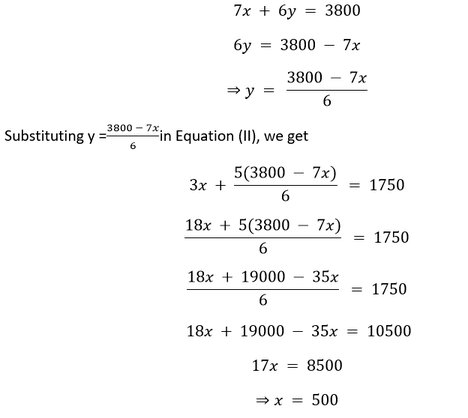
Using x = 500 in Equation (I), we get 7 × 500 + 6y = 3800 3500 + 6y = 3800 6y=300 Hence, the cost of 1 bat is Rs 500, and the cost of 1 ball is Rs 50. IV. Let the fixed charge of the taxi (in rupees) be x and the charge for each km of distance covered (in rupees) be y. It is given that the total fare of the taxi for a distance of 10 km is Rs 105, therefore x + 10y = 105 ... Equation (I) It is also given that the total fare of the taxi for a distance of 15 km is Rs 155, therefore x + 15y = 155 ... Equation (II) From Equation (I): x + 10y = 105 x = 105 - 10y Substituting x = 105 - 10y in Equation (II), we get 105 - 10y + 15y = 155 5y = 50 ⇒ y = 10 Using y = 30 in Equation (I), we get x + 10 × 10 = 105 x + 100 = 105 ⇒ x = 5 Hence, the fixed charge is Rs 5 and the charge per km is Rs 10. For a journey of 25 km, the fare will be x + 25y = 5 + 25(10) = 5 + 250 = 255 Hence, the fare for a journey of 25 km is Rs 255. V. Let the numerator be x and the denominator be y. It is given that the fraction becomes 9/11, if 2 is added to the numerator as well as denominator, therefore (x + 2)/(y + 2) = 9/11 ... Equation (I) It is also given that the fraction becomes 5/6, if 3 is added to the numerator as well as denominator, therefore (x + 3)/(y + 3) = 5/6 ... Equation (II) From Equation (I): 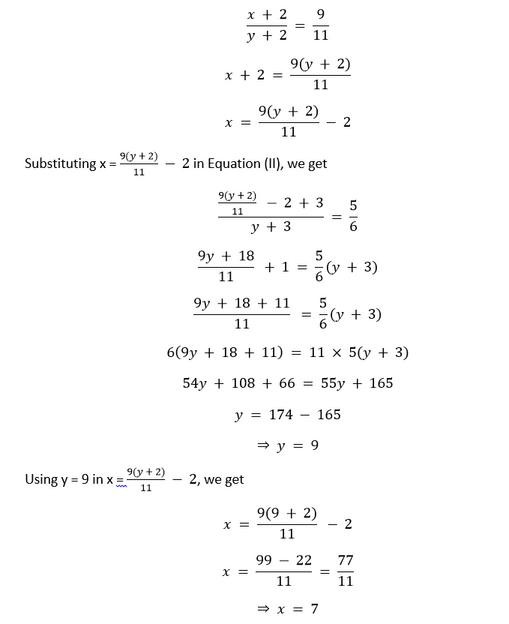
The numerator is 7, and the denominator is 9. Hence, the fraction is 7/9. VI. Let the present age of Jacob (in years) be x and let the present age of his son (in years) be y. It is given that five years later, Jacob's age will be three times that of his son, therefore x + 5 = 3(y + 5) ... Equation (I) It is also given that five years ago, Jacob's age was seven times that of his son, therefore x - 5 = 7(y - 5) ... Equation (II) From Equation (I): x + 5 = 3(y + 5) x = 3(y + 5) - 5 Substituting x = 3(y + 5) - 5 in Equation (II), we get 3(y + 5) - 5 - 5 = 7(y - 5) 3y + 15- 10 = 7y - 35 40 = 4y ⇒ y = 10 Using y = 10 in x = 3(y + 5) - 5, we get x = 3(10 + 5) - 5 x = 45 - 5 ⇒ x = 40 Hence, Jacob's present age (in years) is 40 while his son's present age (in years) is 10. Exercise 3.41. Solve the following pair of linear equations by the elimination method and the substitution method :
Solution I. x + y = 5 ... Equation (I) 2x - 3y = 4 ... Equation (II) By Elimination Method:- Multiply Equation (I) by 3 and add it to Equation (II) 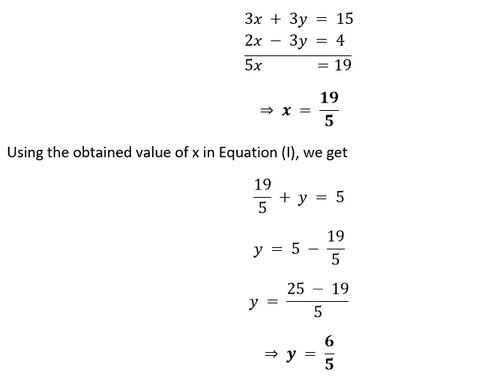
By Substitution Method:- From Equation (I): x + y = 5 y = 5 - x Substituting y = 5 - x in Equation (II), we get 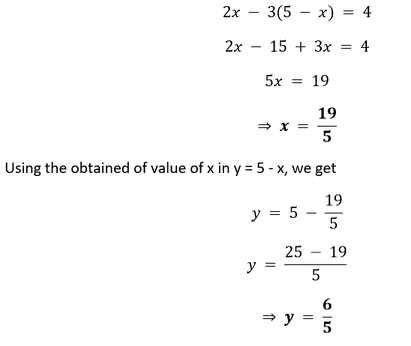
II. 3x + 4y = 10 ... Equation (I) 2x - 2y = 2 ... Equation (II) By Elimination Method:- Multiply Equation (II) by 2 and add it to Equation (I) 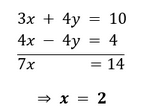
Using the obtained value of x in Equation (I), we get 3(2) + 4y = 10 4y = 10 - 6 4y = 4 ⇒ y = 1 By Substitution Method:- From Equation (I): 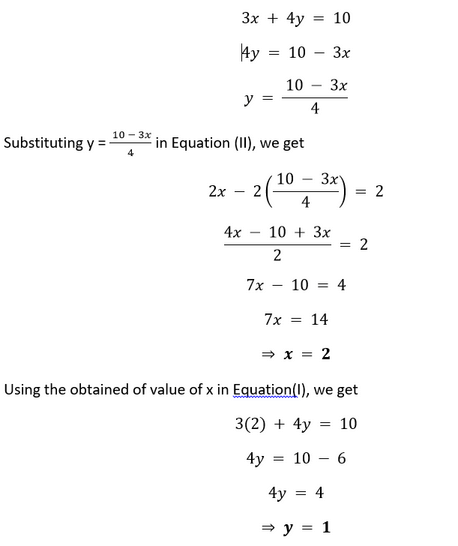
Substituting y = in Equation (II), we get III. 3x - 5y = 4 ... Equation (I) 9x - 2y = 7 ... Equation (II) By Elimination Method:- 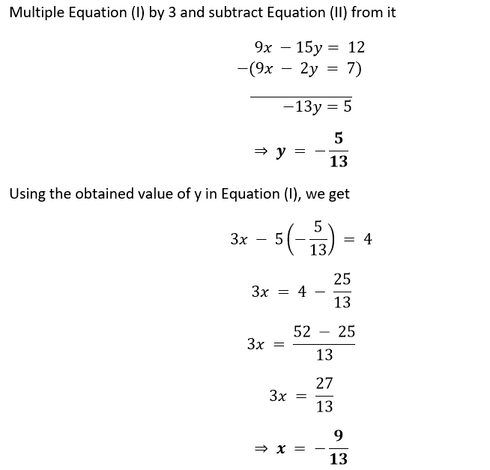
By Substitution Method:- From Equation (II), we have 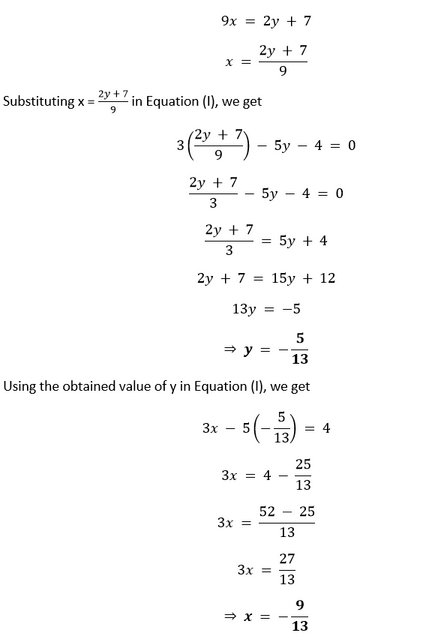
IV. x/2 + 2y/3 = -1 ... Equation (I) x - y/3 = 3 ... Equation (II) By Elimination Method:- Multiply Equation (II) by 2 and add it to Equation (I) 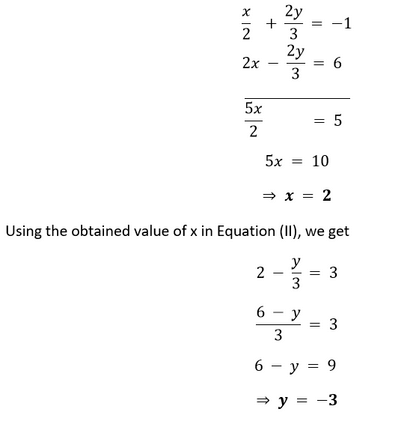
By Substitution Method:- From Equation (II), we have 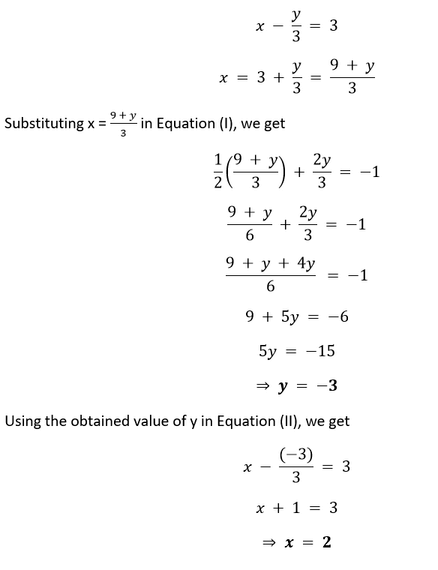
2. Form the pair of linear equations in the following problems, and find their solutions (if they exist) by the elimination method :
Solution I. Let the numerator be x and let the denominator be y. It is given that if we add 1 to numerator and subtract 1 from denominator the fraction becomes 1, therefore (x + 1)/(y - 1) = 1 x + 1 = y - 1 x - y = -2 ... Equation (I) It is also given that the fraction becomes � if we add 1 to denominator, therefore x/(y + 1) = � 2x = y + 1 2x - y = 1 ... Equation (II) Subtract Equation (I) from Equation (II) 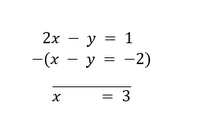
Using the obtained value of x in Equation (I), we get 3 - y= -2 y = 5 Hence, the numerator is 3 and the denominator is 5. The required fraction is 3/5. II. Let the present age of Nuri (in years) be x and let the present age of Sonu (in years) be y. It is given that 5 years ago, Nuri's age was 3 times that of Sonu, therefore x - 5 = 3(y - 5) x - 5 = 3y - 15 x - 3y = -10. ... Equation (I) It is also given that ten years into the future, Nuri's age will be two times that of Sonu, therefore x + 10 = 2(y + 10) x + 10 = 2y + 20 x - 2y = 10. ... Equation (II) Subtract Equation (I) from Equation (II) 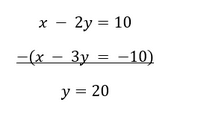
Using the obtained value of y in Equation (II), we get x-2(20)=10 x-40=10 x = 50 Therefore, the present age of Niru (in years) is 50, while the present age of Sonu (in years) is 20. III. Let the tens digit of the number be x and let the ones digit of the number be y. The number will be 10x + y. It is given that the sum of both the digits is 9, therefore x + y = 9 ... Equation (I) It is also given that that 9 times this number is twice of the number obtained when the digits get reversed (number when digits gets reversed = 10y + x), therefore 9(10x + y) = 2(10y + x) 90x + 9y = 20y + 2x 88x - 11y = 0 11(8x - y) = 0 8x - y = 0 ... Equation (II) Add Equation (I) and Equation (II) 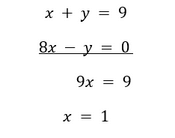
Using the obtained value of x in Equation (I), we get 1 + y = 9 y = 8 Hence, the tenth digit of the number is 1 while the ones digit of the number is 8. The required number is 18. IV. Let the number of Rs 50 notes Meena received be x and let the number of Rs 100 notes she received be y. It is given that the total sum of money of the Rs 50 and Rs 100 notes was Rs 2000, therefore 50x + 100y = 2000 50(x + 2y) = 2000 x + 2y = 40 ... Equation (I) It is also given that the total number of notes she received was 25, therefore x + y = 25 ... Equation (II) Subtracting Equation (II) from Equation (I) 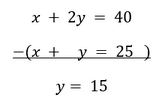
Using the obtained value of y in Equation (II), we get x + 15 = 25 x = 10 Hence, Meena received 10 Rs 50 notes and 15 Rs 100 notes. V. Let the fixed charge of the lending library (in rupees) be x and let the charge per day (in rupees) be y. It is given that Saritha kept the book for seven days, and paid Rs 27, therefore x + 7y = 27 ... Equation (I) It is also given that Susy kept the book for five days, and paid Rs 21, therefore x + 5y = 21 ... Equation (II) Subtract Equation (II) from Equation (I) 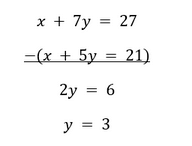
Using the obtained value of y in Equation (I), we get x + 7(3) = 27 x + 21 = 27 x = 6 Hence, the fixed charge of the lending library is Rs 6 while the charge for each subsequent day is Rs 3. Exercise 3.5Which of the following pair of linear equations has a unique solution, no solution or infinitely many solutions. In case there is a unique solution, find it by using the cross multiplication method.
Solution I. On comparing the two given equations with a 1x + b1y + c1 = 0 and a 2x + b2y + c2 = 0, we get a1 = 1, b1 = -3, and c1 = -3 a2 = 3, b2 = -9, and c2 = -2 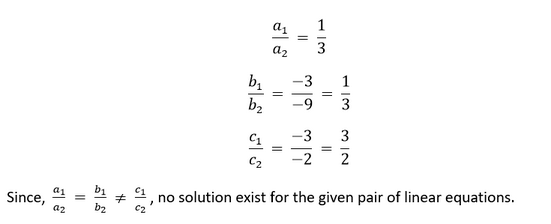 < <
II. On comparing the two given equations with a1x + b1y + c1 = 0 and a2x + b2y + c2 = 0, we get a1 = 2, b1 = 1, and c1 = -5 a2 = 3, b2 = 2, and c2 = -8 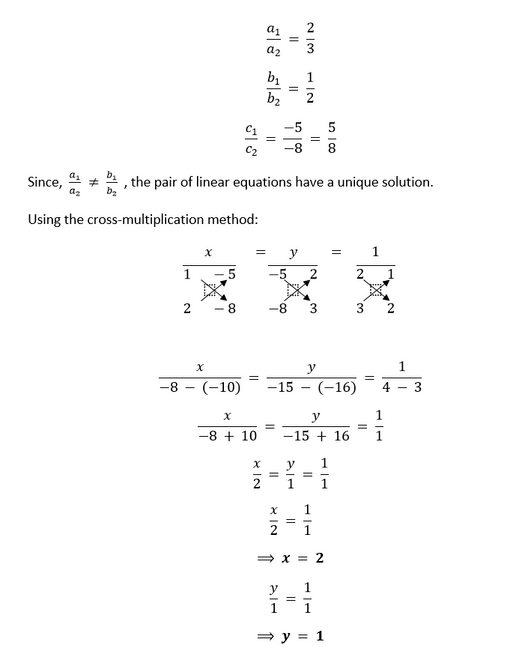
III. On comparing the two given equations with a1x + b1y + c1 = 0 and a2x + b2y + c2 = 0, we get a1 = 3, b1 = -5, and c1 = -20 a2 = 6, b2 = -10, and c2 = -40 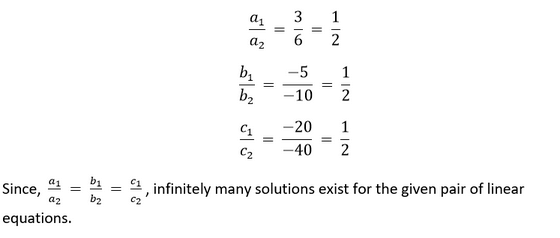
IV. On comparing the two given equations with a1x + b1y + c1 = 0 and a2x + b2y + c2 = 0, we get a1 = 1, b1 = -3, and c1 = -7 a2 = 3, b2 = -3, and c2 = -15 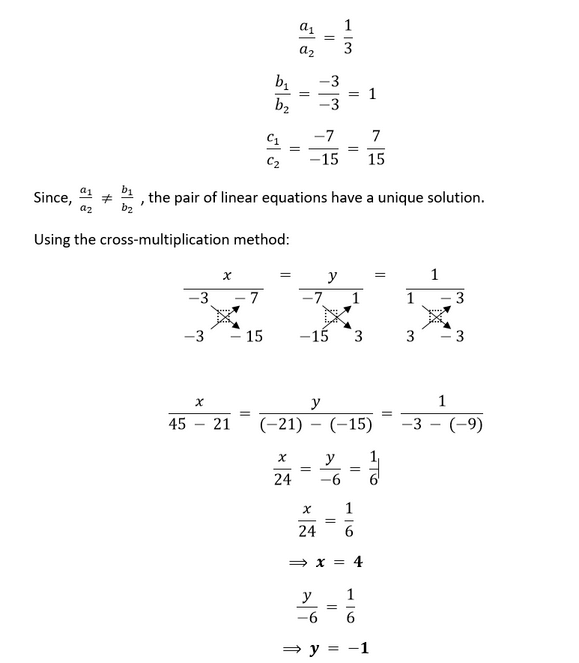
2. I. For which values of a and b does the following pair of linear equations have an infinite number of solutions? 2x + 3y = 7 (a - b) x + (a + b) y = 3a + b - 2 II. For which value of k will the following pair of linear equations have no solution? 3x + y = 1 (2k - 1) x + (k - 1) y = 2k + 1 Solution 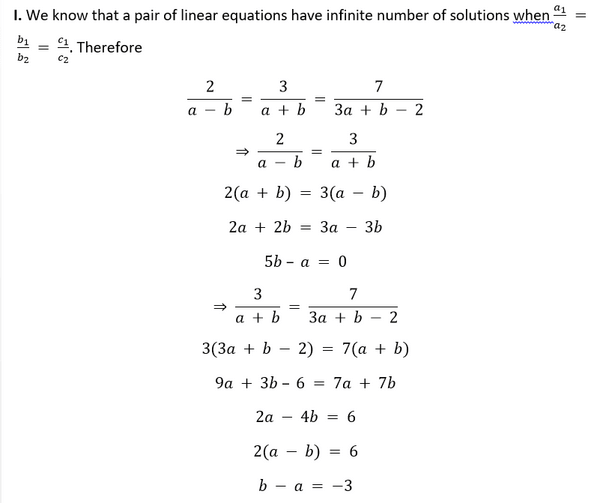
We can solve the equation 5b - a = 0 and a - b = 3 by using the cross-multiplication method: 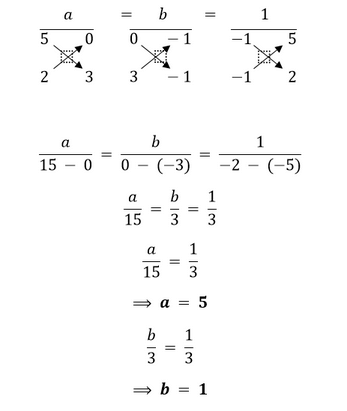
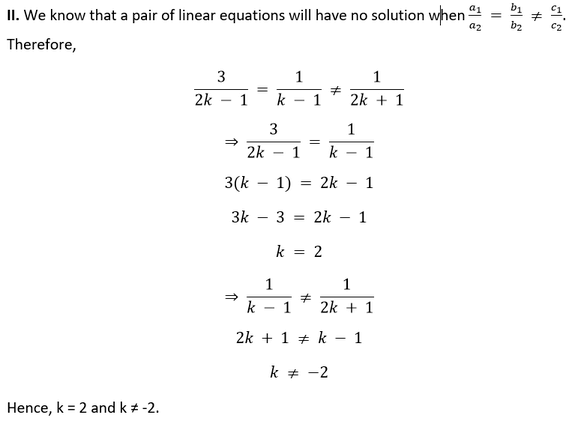
3. Solve the following pair of linear equations by the substitution and cross-multiplication methods : 8x + 5y = 9 3x + 2y = 4 Solution 8x + 5y = 9 ... Equation (I) 3x + 2y = 4 ... Equation (II) By Substitution Method :- From Equation (I) we have : 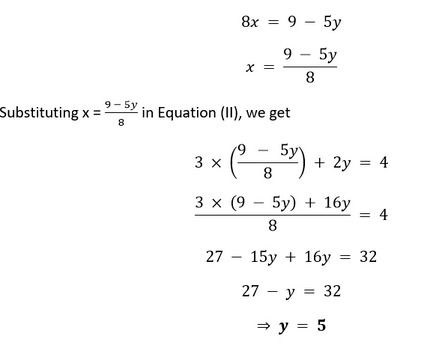
Using the obtained value of y in Equation (I), we get 8x + 5 (5) = 9 8x + 25 = 9 8x = -16 ⇒ x = -2 By Cross-multiplication Method:- On comparing Equation (I) with a 1x + b1y + c1 = 0 and Equation (II) with a 2x + b2y + c2 = 0, we get a1 = 8, b1 = 5, and c1 = -9 a2 = 3, b2 = 2, and c2 = -4 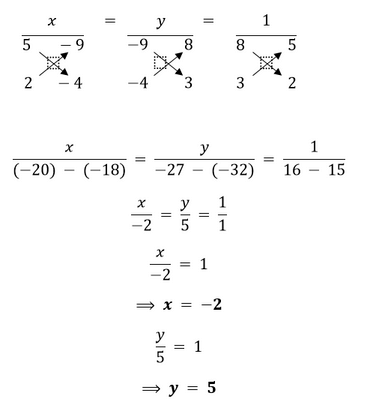
4. Form the pair of linear equations in the following problems and find their solutions (if they exist) by any algebraic method :
Solution I. Let the fixed charge of the hostel (in rupees) be x and let the charge for each day food is taken in the mess (in rupees) be y. It is given that Student A paid Rs 1000 after staying for 20 days, therefore x + 20y = 1000 ... Equation (I) According to the second case, Student B paid Rs 1180 after staying for 26 days, therefore x + 26y = 1180 ... Equation (II) On comparing Equation (I) with a1x + b1y + c1 = 0 and Equation (II) with a2x + b2y + c2 = 0, we get a1 = 1, b1 = 20, and c1 = -1000 a2 = 1, b2 = 26, and c2 = -1180 By applying the cross-multiplication method: 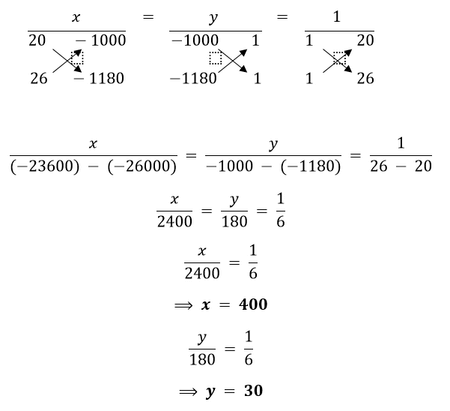
Hence, the fixed charge of the Hostel is Rs 400 while the charge for each day is Rs 30. II. Let the numerator be x and let the denominator be y. It is given that the fraction becomes 1/3 after subtracting 1 from the numerator, therefore (x - 1)/y = 1/3 3(x - 1) = y 3x - 3 = y 3x - y = 3 ... Equation (I) According to the second case, the fraction becomes 1/4 after adding 8 to the denominator, therefore x/(y + 8) = ¼ 4x = y + 8 4x - y = 8 ... Equation (II) On comparing Equation (I) with a1x + b1y + c1 = 0 and Equation (II) with a2x + b2y + c2 = 0, we get a1 = 3, b1 = -1, and c1 = -3 a2 = 4, b2 = -1, and c2 = -8 By applying the cross-multiplication method: 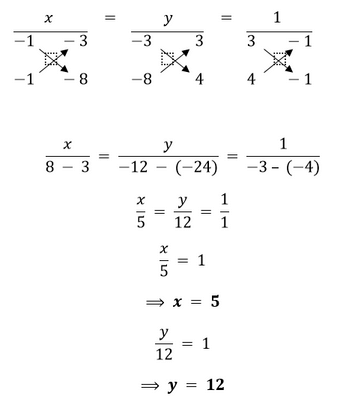
Hence, the numerator is 5 while the denominator is 12. The required fraction is 5/12. III. Let the number of questions answered correctly by Yash be x and let the number of questions answered incorrectly by Yash be y. It is given that Yash scored 40 marks when 3 marks are awarded for each correct answer while 1 mark is deducted for each incorrect answer, therefore 3x - y = 40 ... Equation (I) It is also given that Yash would have scored 50 marks if 4 marks were awarded for each correct answer and 2 marks were deducted for each incorrect answer, therefore 4x - 2y = 50 ... Equation (II) On comparing Equation (I) with a1x + b1y + c1 = 0 and Equation (II) with a2x + b2y + c2 = 0, we get a1 = 3, b1 = -1, and c1 = -40 a2 = 4, b2 = -2, and c2 = -50 By applying the cross-multiplication method: 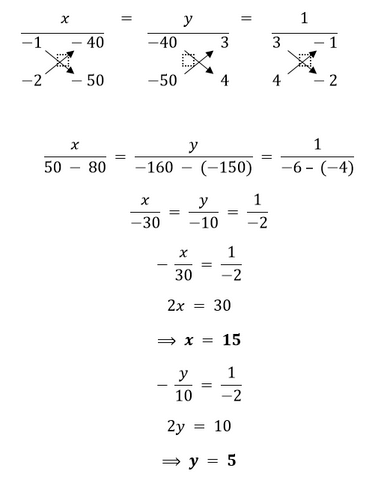
Hence, Yash answered 15 question correctly and 5 questions incorrectly. The total number of questions is 15 + 5 = 20. IV. Let the speed of the car that starts from point A = x km/h and let the speed of the car that starts from point B = y km/h. It is given that the distance between A to B is 100 km. and that if they travel in same directions, it takes them 5 hours to meet. The distance covered by the cars in 5 hours can be calculated by using Distance = Speed × Time Therefore 5x - 5y = 100 5(x - y) = 100 x - y = 20 ... Equation (I) It is also given that the two cars meet in 1 hour when they travel towards each other, i.e. in opposite directions, therefore x + y = 100 ... Equation (II) On comparing Equation (I) with a1x + b1y + c1 = 0 and Equation (II) with a2x + b2y + c2 = 0, we get a1 = 1, b1 = -1, and c1 = -20 a2 = 1, b2 = 1, and c2 = -100 By applying the cross-multiplication method: 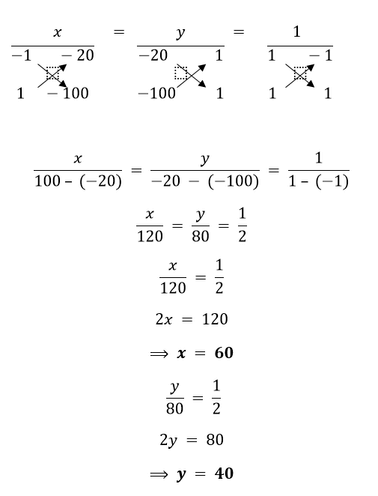
Hence, the speed of the car that starts from point A is 60 km/h and the speed of the car that starts from point B is 40 km/h. V. Let the length of the rectangle (in units) be x and let the breadth of the rectangle (in units) be y. We know that Area of Rectangle = Length × Breadth Therefore, Area = xy It is given that the Area of rectangle is reduced by 9 square units if we reduce the length by 5 units and increase the breadth by 3 units, therefore (x - 5) (y + 3) = xy - 9 xy - 5y + 3x - 15 = xy - 9 3x - 5y - 15 = -9 3x - 5y = 6 ... Equation (I) It is also given that the Area of the rectangle is increased by 67 square units if we increase the length by 3 units and increase the breadth by 2 units, therefore (x + 3) (y + 2) = xy + 67 xy + 3y + 2x + 6 = xy + 67 2x + 3y + 6 = 67 2x + 3y = 61 ... Equation (II) On comparing Equation (I) with a�1x + b1y + c1 = 0 and Equation (II) with a�2x + b2y + c2 = 0, we get a1 = 3, b1 = -5, and c1 = -6 a2 = 2, b2 = 3, and c2 = -61 By applying the cross-multiplication method: 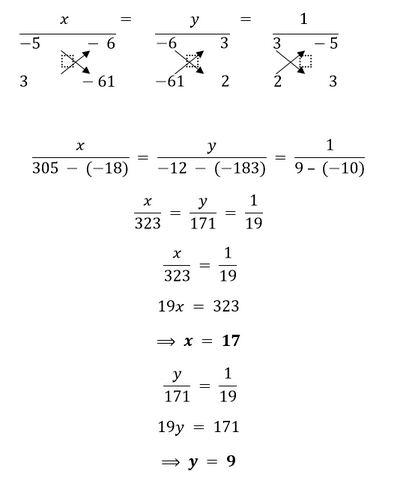
Hence, the length of the rectangle is 17 units and the breadth of the rectangle is 9 units. Exercise 3.61. Solve the following pairs of equations by reducing them to a pair of linear equations:
Solution I. Let 1/x = u and 1/y = v. u/2 + v/3 = 2 ... Equation (I) u/3 + v/2 = 13/6 ... Equation (II) Multiply Equation (I) by 2 and Equation (II) by 3, then subtract Equation (II) from Equation (I) 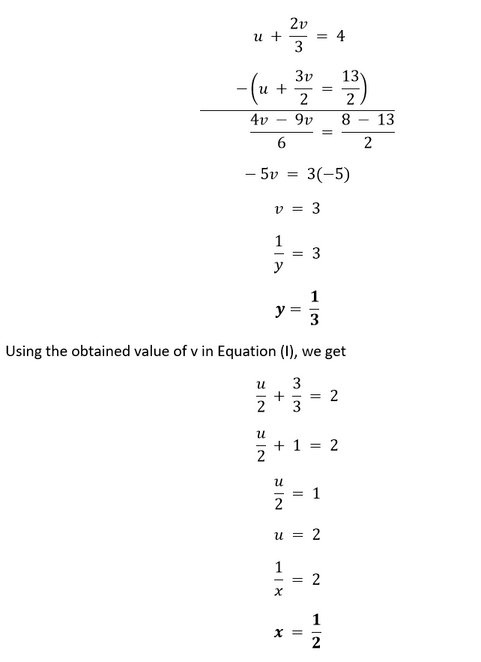
Hence, the solution for given pair of equations is x = 1/2 and y = 1/3. II. Let 1/√x = u and 1/√y = v 2u + 3v = 2 ... Equation (I) 4u - 9v = -1 ... Equation (II) Multiply Equation (I) by 2, then subtract Equation (II) from Equation (I) 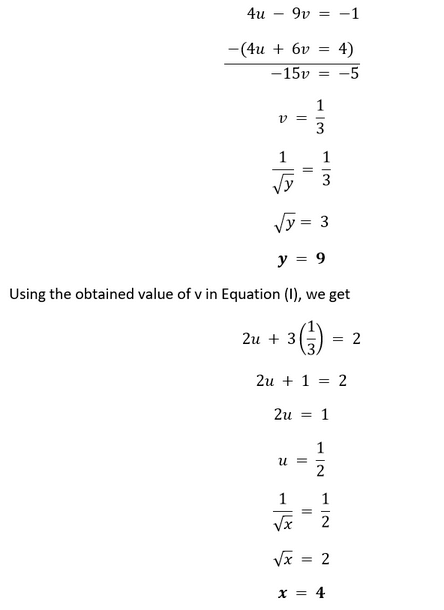
Hence, the solution for given pair of equations is x = 4 and y = 9. III. Let 1/x = u. 4u + 3y = 14 ... Equation (I) 3u - 4y = 23 ... Equation (II) From Equation (I), we have 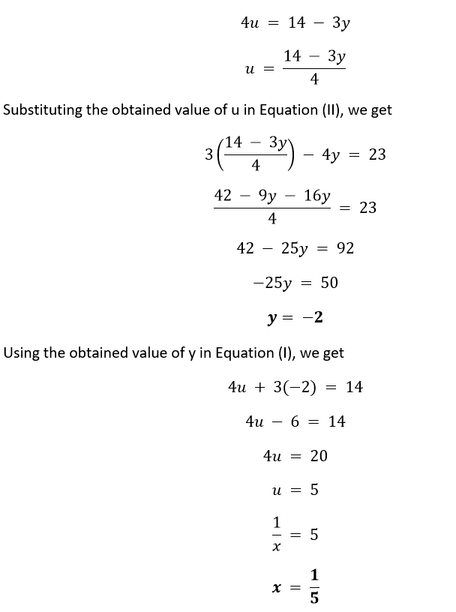
Hence, the solution for given pair of equations is x = 1/5 and y = -2. IV. Let 1/(x - 1) = u and 1/(y - 2) = v. 5u + v = 2 ... Equation (I) 6u - 3v = 1 ... Equation (II) From Equation (I), we have 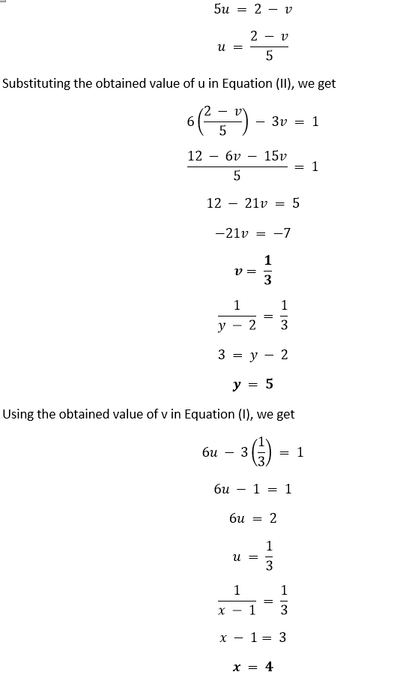
Hence, the solution for given pair of equations is x = 4 and y = 5. V. 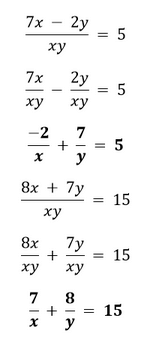
Let 1/x = u and 1/y = v. -2u + 7v = 5 ... Equation (I) 7u + 8v = 15 ... Equation (II) From Equation (I) we have 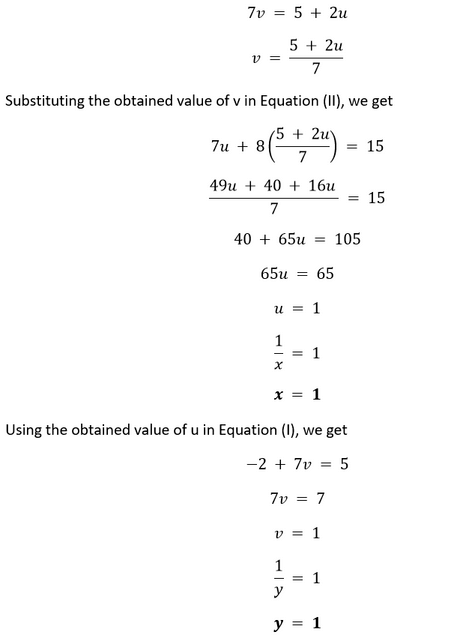
Hence, the solution for given pair of equations is x = 1 and y = 1. VI. 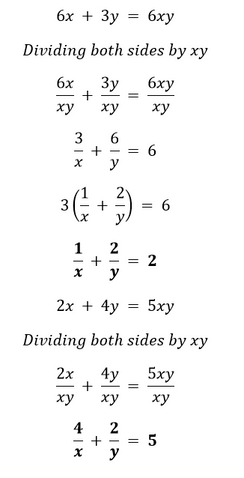
Let 1/x = u and 1/y = v. u + 2v = 2 ... Equation (I) 4u + 2v = 5 ... Equation (II) From Equation (I) we have u = 2 - 2v Substituting the obtained value of u in Equation (II), we get 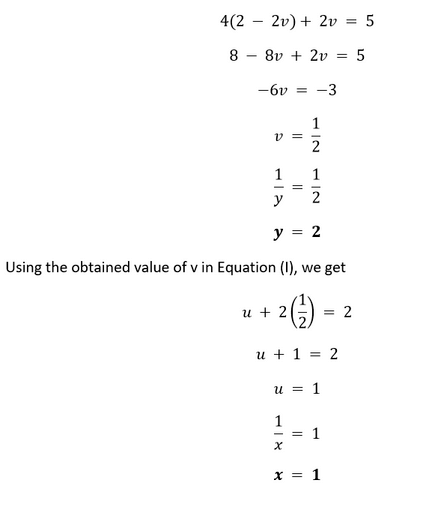
Hence, the solution for given pair of equations is x = 1 and y = 2. VII. Let 1/(x + y) = u and 1/(x - y) = v. 10u + 2v = 4 ... Equation (I) 15u - 5v = -2 ... Equation (II) From Equation (I) we have 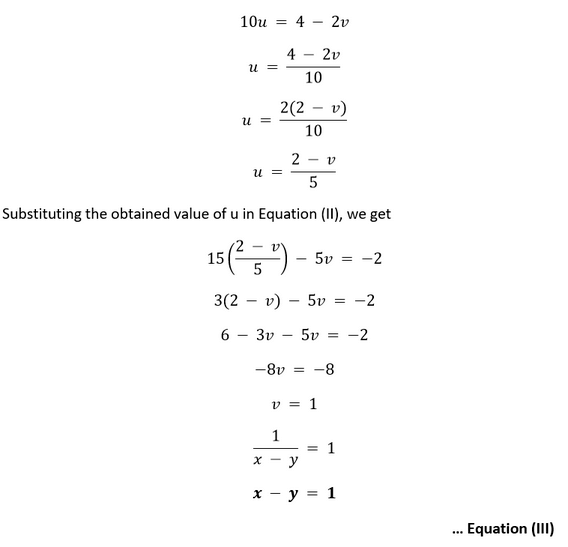
Using the obtained value of v in Equation (I), we get 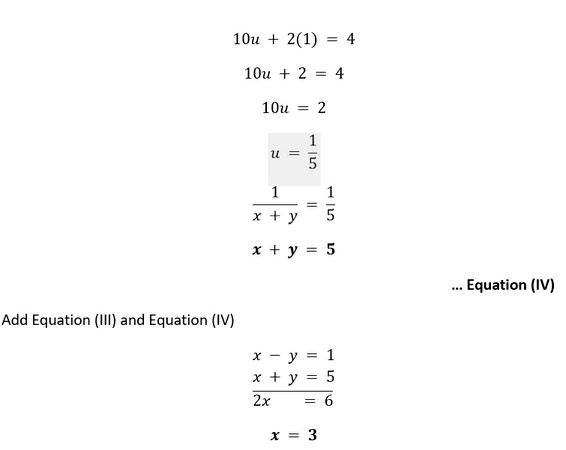
Using x = 3 in Equation (III) we get 3 - y = 1 y = 2 Hence, the solution for given pair of equations is x = 3 and y = 2. VII. Let 1/(3x + y) = u and 1/(3x - y) = v. u + v = 3/4 4u + 4v = 3 ... Equation (I) u/2 - v/2 = -1/8 4u - 4v = -1 ... Equation (II) Add Equation (I) and Equation (II) 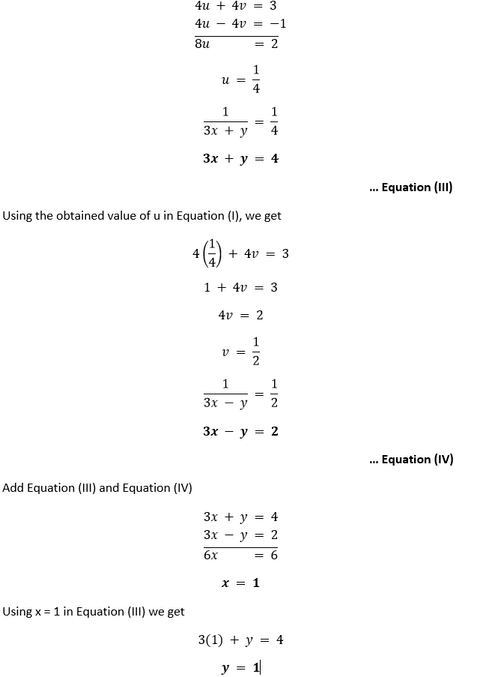
Hence, the solution for given pair of equations is x = 1 and y = 1. 2. Formulate the following problems as a pair of equations, and hence find their solutions:
Solution I. Let the speed of Ritu rowing in still water be x km/h and let the speed of the water current be y km/h. Her rowing speed during downstream = (x + y) km/h Her rowing speed during upstream = (x - y) km/h We know that 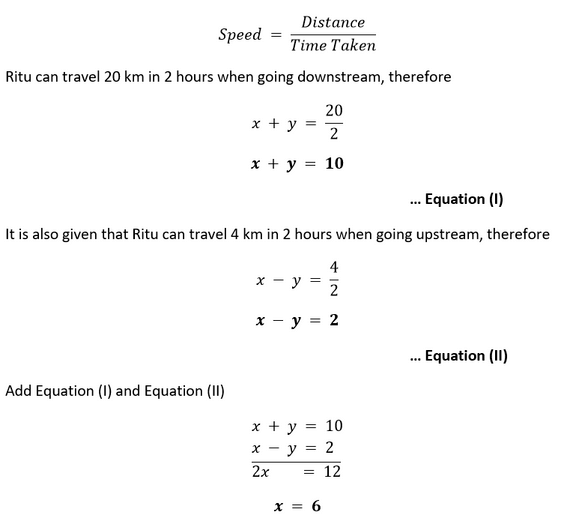
Using the obtained value of x in Equation (II) we get 6 - y = 2 y = 4 Hence, the speed of rowing in still water is 6 km/h while the speed of the current is 4 km/h. II. Let the time taken by 1 woman to finish the embroidery work (in days) be x. Let the time taken by 1 man to finish the embroidery work (in days) be y. It takes 2 women and 5 men a total of 4 days to finish the work, therefore 2/x + 5/y = 1/4 ... Equation (I) It is also given that 3 women and 6 men can finish the work in 3 days, therefore 3/x + 6/y = 1/3 3(3/x + 6/y) = 1 9/x + 18/y = 1 ... Equation (II) Let 1/x = u and let 1/y = v. 2u + 5v = ¼ ... Equation (III) 9u + 18v = 1 ... Equation (IV) From Equation (IV), we have 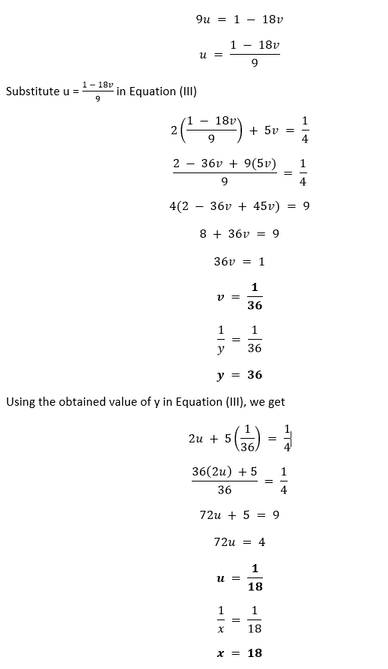
Hence, the time taken by 1 woman to complete the embroidery work is 18 days while the time taken by 1 man to complete the embroidery work is 36 days. III. Let the speed of the train (in km/h) be x and let the speed of the bus (in km/h) be y. We know that 
Since, it takes Roohi 4 hours to cover 300 km if she travels 60 km by train and the rest by bus, therefore 60/x + (300 - 60)/y = 4 60/x + 240/y = 4 4(15/x + 60/y) = 4 15/x + 60/y = 1 ... Equation (I) It is also given that Roohi takes 4 + 10/60 = 25/6 hours if she travels 100 km by train and the rest by bus, therefore 100/x + (300 - 100)/y = 25/6 100/x + 200/y = 25/6 25(4/x + 8/y) = 25/6 24/x + 48/y = 1 ... Equation (II) Let 1/x = u and 1/y = v. 15u + 60v = 1 ... Equation (III) 24u + 48v = 1 ... Equation (IV) From Equation (III), we have: 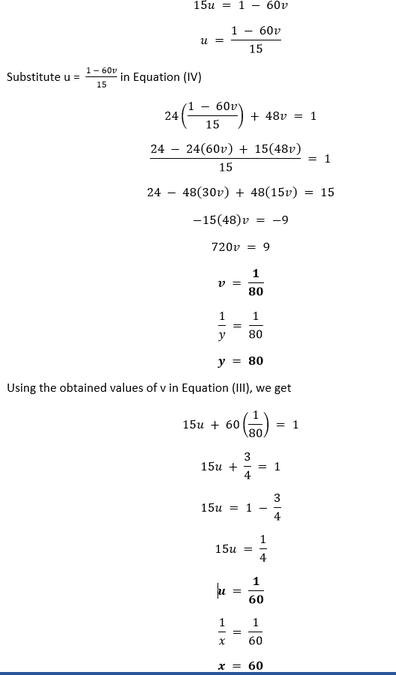
Hence, the speed of the train is 60 km/h and the speed of the bus is 80 km/h. Exercise 3.7 (Optional)1. The ages of two friends Ani and Biju differ by 3 years. Ani's father Dharam is twice as old as Ani and Biju is twice as old as his sister Cathy. The ages of Cathy and Dharam differ by 30 years. Find the ages of Ani and Biju. Solution Let the age of Ani (in years) be x and let the age of Biju (in years) be y. Since, the difference is age of Ani and Biju is 3 years, therefore x - y = 3 assuming Ani is older OR y - x = 3 assuming Biju is older x - y = -3 ... Equation (I) Dharam's age = 2x Cathy's age = y/2 Since, the difference in age of Dharam and Cathy is 30 years, therefore 2x - y/2 = 30 (4x - y)/2 = 30 4x - y = 60 ... Equation (II) From Equation (II), we have: 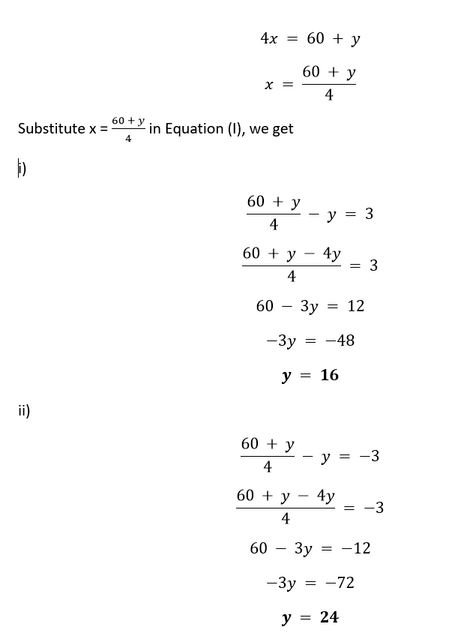
Using the obtained values of y in Equation (II), we get i) x - 16 = 60 4x = 76 x = 19 OR ii) 4x - 24 = 60 4x = 84 x = 21 Hence, the age of Ani and Biju is 19 years and 16 years respectively OR 21 years and 24 years respectively. 2. One says, "Give me a hundred, friend! I shall then become twice as rich as you". The other replies, "If you give me ten, I shall be six times as rich as you". Tell me what is the amount of their (respective) capital? [From the Bijaganita of Bhaskara II] [Hint : x + 100 = 2(y - 100), y + 10 = 6(x - 10)]. Solution Let one friend be carrying Rs x and the other be carrying Rs y. If the first friend receives a hundred from the other, their capital would be Rs (x + 100) and Rs (y - 100) respectively. The first friend has twice the money after receiving Rs 100 from the other friend, therefore x + 100 = 2(y - 100) x + 100 = 2y - 200 x - 2y = -300 ... Equation (I) If the second friend receives ten from the first, their capital would be Rs (y + 10) and Rs (x - 10) respectively. The second friend has six times the money after receiving Rs 10 from the first friend, therefore y + 10 = 6(x - 10) y + 10 = 6x - 60 6x - y = 70 ... Equation (II) From Equation (II), we have: 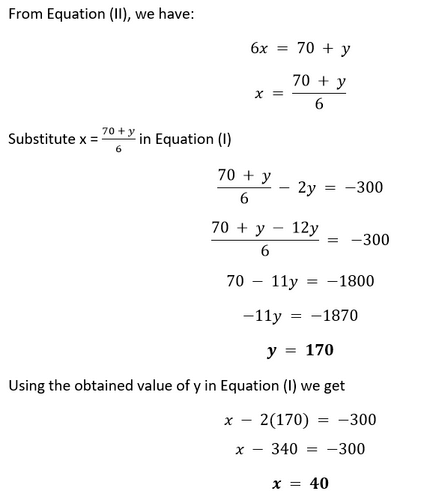
Therefore, the first friend has Rs 40 and the second friend has Rs 170. 3. A train covered a certain distance at a uniform speed. If the train would have been 10 km/h faster, it would have taken 2 hours less than the scheduled time. And, if the train were slower by 10 km/h; it would have taken 3 hours more than the scheduled time. Find the distance covered by the train. Solution Let the original speed of the train (in km/h) be x and let the time taken for the journey to complete (in hours) be y. We know that, Distance = Speed × Time Taken Therefore, distance travelled by train (in km) = xy It is given that if the speed was 10 km/h faster, then the journey would have taken 2 hours less, therefore xy = (x + 10) (y - 2) xy = xy - 2x + 10y - 20 20 = -2x + 10y 20 = -2(x - 5y) x - 5y = -10 ... Equation (I) It is also given that if the speed had been 10 km/h slower, then the journey would have taken 3 hours more, therefore xy = (x - 10) (y + 3) xy = xy + 3x - 10y - 30 30 = 3x - 10y 3x - 10y = 30 ... Equation (II) From Equation (I), we have: x = -10 + 5y Substitute x = -10 + 5y in Equation (II) 3(-10 + 5y) - 10y = 30 -30 + 15y - 10y = 30 5y = 60 y = 12 Using the obtained value of y in Equation (I), we get x - 5(12) = -10 x - 60 = -10 x = 50 Therefore, the original speed of the train is 50 km/h and the original time taken by it to travel the distance is 12 hours. Hence, the distance covered by the train = xy = 50 × 12 = 600 km. 4. The students of a class are made to stand in rows. If 3 students are extra in a row, there would be 1 row less. If 3 students are less in a row, there would be 2 rows more. Find the number of students in the class. Solution Let the number of rows be x and let the number of students standing in each row be y. Total number of students = x × y It is given that if there were 3 more students in a row then the number of rows would be reduced by 1, therefore xy = (x - 1) (y + 3) xy = xy +3x - y - 3 3x - y = 3 ... Equation (I) It is also given that the number of rows would increase by 2 if the number of students in each row were reduced by 3, therefore xy = (x + 2) (y - 3) xy = xy - 3x + 2y - 6 6 = 2y - 3x 3x - 2y = -6 ... Equation (II) From Equation (I), we have: 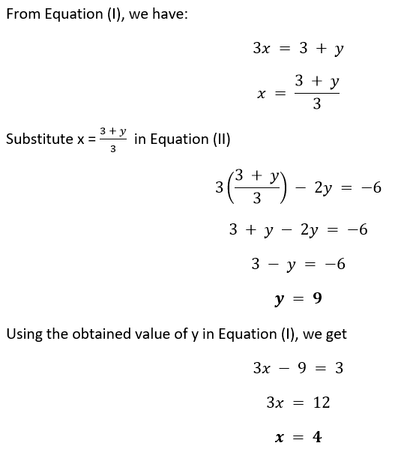
Therefore, the number of rows = 4 and the number of students in each row = 9. The Total Number of students in the class = xy = 4 × 9 = 36. 5. In a ?ABC, ∠ C = 3 ∠ B = 2 (∠ A + ∠ B). Find the three angles. Solution Let the ∠A = x (in degrees) and let ∠B = y (in degrees). Now, ∠C = 3y = 2(x + y) 3y = 2x + 2y y = 2x 2x - y = 0 ... Equation (I) According to the Angle Sum Theorem for the triangle, ∠A + ∠B + ∠C = 180 x + y + 3y = 180 x + 4y = 180 ... Equation (II) From Equation (I), we have: 2x = y Substitute y = 2x in Equation (II) x + 4(2x) = 180 x + 8x = 180 9x = 180 x = 20 Using the obtained value of x in Equation (I), we have 2(20) - y = 0 40 = y Hence, ∠A = 20°, ∠B = 40°, ∠C = 3(40) ° = 120° 6. Draw the graphs of the equations 5x - y = 5 and 3x - y = 3. Determine the co-ordinates of the vertices of the triangle formed by these lines and the y axis. Solution 5x - y = 5 ... Equation (I) 3x - y = 3 ... Equation (II) Next we need to put in some values for any one variable and find the other in order to find the required coordinates to mark the graph. We will be putting values in x and calculating y from the equation. NOTE : Since students have the freedom to assume any values they desire, it is recommended to pick the ones that make calculations easierFor Equation (I):
For Equation (II):
The following graph will be obtained upon plotting the equations: 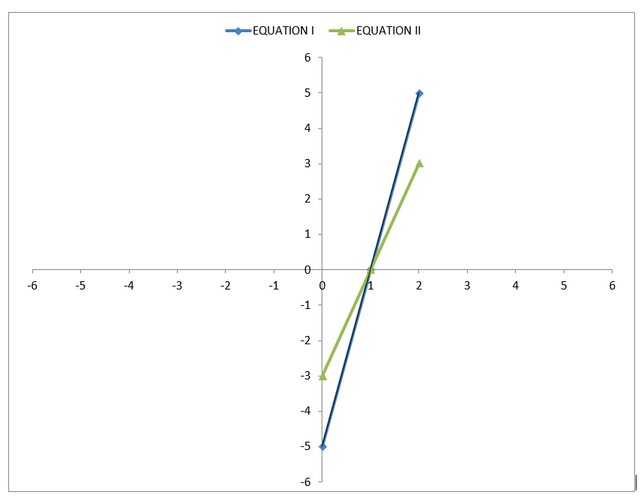
The triangle is formed by the vertices (0, -5), (0, -3), (1, 0). 7. Solve the following pair of linear equations :
Solution I. px + qy = p - q ... Equation (I) qx - py = p + q ... Equation (II) Multiply Equation (I) by p and Equation (II) by q, then add the obtained equations 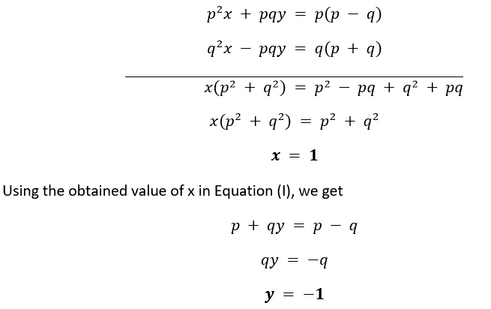
II. ax + by = c ... Equation (I) bx + ay = 1 + c ... Equation (II) Multiply Equation (I) by b and Equation (II) by a 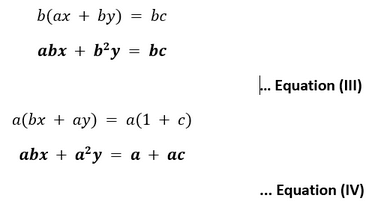
Subtract Equation (III) from Equation (IV) 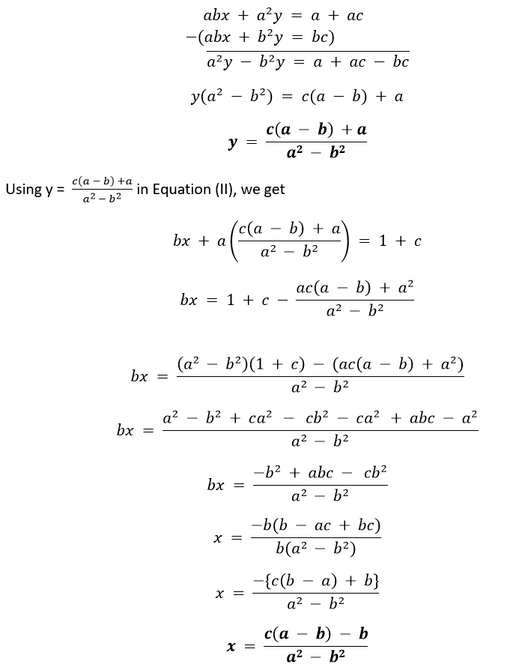
III. x/a -y/b = 0 (bx - ay)/ab = 0 bx - ay = 0 ... Equation (I) ax + by = a2 + b2 ... Equation (II) 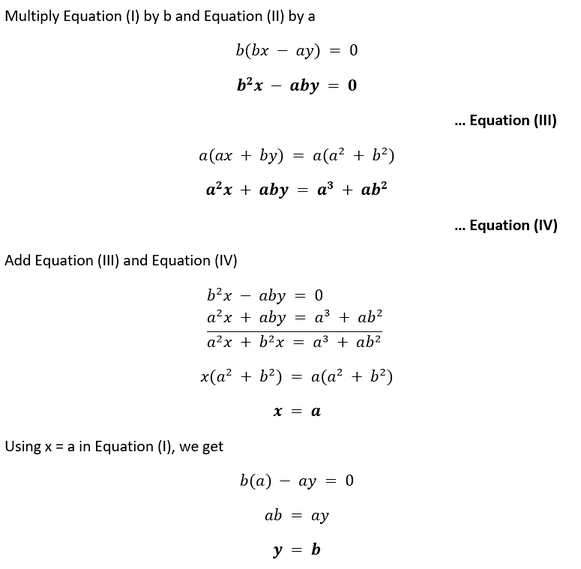
IV. (a - b)x + (a + b) y = a2 - 2ab - b2 ... Equation (I) (a + b)(x + y) = a2 + b2 (a+b)x + (a+b)y = a2 + b2 ... Equation (II) Subtract Equation (II) from Equation (I) 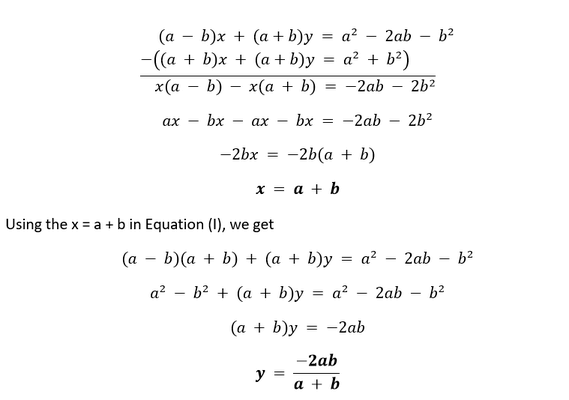
V. 152x - 378y = - 74 2(76x - 189y) = -74 76x - 189y = -37 ... Equation (I) -378x + 152y = -604 2(-189x + 76y) = -604 -189x + 76y = -302 ... Equation (II) Multiple Equation (I) by 76 and Equation (II) by 189 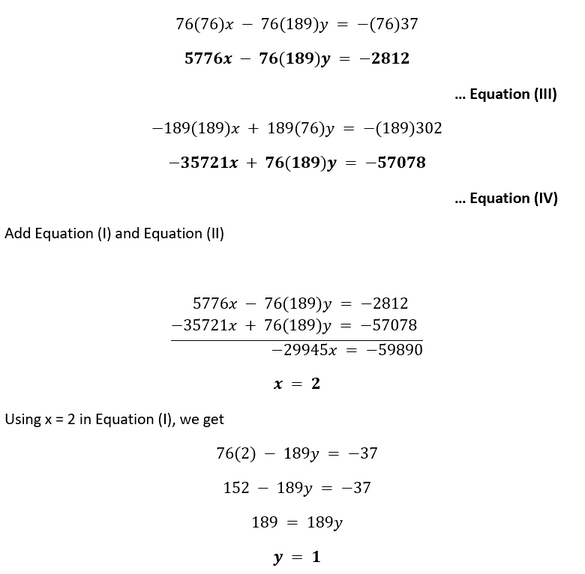
8. ABCD is a cyclic quadrilateral (see given figure). Find the angles of the cyclic quadrilateral. 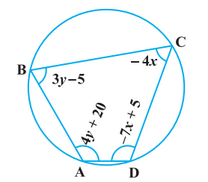
SOLUTION Since ABCD is a cyclic quadrilateral, the sum of opposite angles will be 180°. By using this knowledge, we can conclude that: 3y - 5 - 7x + 5 = 180 7x - 3y = -180 ... Equation (I) AND 4y + 20 - 4x = 180 -4(x - y - 5) = 180 x - y - 5 = -45 x - y = -40 ... Equation (II) From Equation (II), we have: x = y - 40 Substitute x = y - 40 in Equation (I) 7(y - 40) - 3y = -180 7y - 280 - 3y = -180 4y = 100 y = 25 Using y = 25 in Equation (II), we get x - 25 = -40 x = -15 Hence, ∠A = 4y + 20 = 4(25) + 20 = 100 + 20 = 120° ∠B = 3y - 5 = 3(25) - 5 = 75 - 5 = 70° ∠C = -4x = -4(-15) = 60° ∠D = -7x + 5 = -7(-15) + 5 = 105 + 5 = 110°
Next TopicClass 10 Maths Chapter 4
|
 For Videos Join Our Youtube Channel: Join Now
For Videos Join Our Youtube Channel: Join Now
Feedback
- Send your Feedback to [email protected]
Help Others, Please Share









